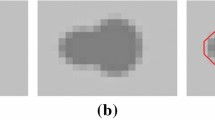Abstract
The problem of image segmentation has been investigated with a focus on inhomogeneous multiphase image segmentation. Intensity inhomogeneity is an undesired phenomenon that represents the main obstacle for magnetic resonance (MR) and natural images segmentation. The complex images usually contain an arbitrary number of objects. This paper presents a new multiphase active contour model method for simultaneous regions classification of MR images and natural images without bias field correction. In this model, a simple and effective initialization method is taken to speed up the curve evolution toward final results; a new multiphase level set method is proposed to segment the multiple regions. This model not only extracts multiple objects simultaneously, but also provides smooth and accurate boundaries of the objects. The results for experiments on several synthetic and real images demonstrate the effectiveness and accuracy of our model.











Similar content being viewed by others
References
Boesen K, Rehm K, Schaper K, Stoltzner S (2004) Quantitative comparison of four brain extraction algorithms. NeuroImage 22(3):1255–1261
Butina D (1999) Unsupervised data base clustering based on daylight’s fingerprint and Tanimoto similarity: a fast and automated way to cluster small and large data sets. J Chem Inf Comput 39:747–750
Chan TF, Vese LA (2001) Active contours without edges. IEEE Trans Image Process 10(2):266–277
Chen W, Giger M (2004) A fuzzy c-means (FCM) based algorithm for intensity inhomogeneity correction and segmentation of MR images. IEEE International Symposium on Biomedical Imaging: From Nano to Macro, Arlington, America, 1307–1310
Chen Z, Qiu T, Su R (2008) FCM and level set based segmentation method for brain MR images. Acta Electron Sin 36(9):1733–1736
Kass M, Witkin A, Terzopoulos D (1988) Snakes: active contour models. Int J Comput Vis 1(4):321–331
Kwan RK, Evans AC, Pike GB (1999) MRI simulation-based evaluation of image-processing and classification methods. IEEE Trans Med Imaging 18(11):1085–1097
Leemput V, Maes K, Vandermeulen D, Suetens P (1999) Automated model-based bias field correction of MR images of the brain. IEEE Trans Med Imaging 18(10):885–896
Li C, Kao CK, Gore JC, Ding Z (2007) Implicit active contours driven by local binary fitting energy. IEEE Conference on Computer Vision and Pattern Recognition, Washington DC, America, 1-7
Li C, Xu C, Gui C, Martin DF (2005) Level set evolution without reinitialization: a new variational formulation. IEEE Computer Society Conference on Computer Vision and Pattern Recognition, San Diego, America, 430–436
Mumford D, Shah J (1989) Optimal approximations by piecewise smooth functions and associated variational problems. Commun Pure Appl Math 42(5):577–685
Pham D, Prince J (1999) Adaptive fuzzy segmentation of magnetic resonance images. IEEE Trans Med Imaging 18(9):737–752
Sled J, Zijdenbos A, Evans A (1998) A nonparametric method for automatic correction of intensity nonuniformity in MRI data. IEEE Trans Med Imaging 17(1):87–97
Styner M, Brechbuhler C, Szekely G, Gerig G (2000) Parametric estimate of intensity inhomogeneities applied to MRI. IEEE Trans Med Imaging 19(3):153–165
Tsai A, Yezzi A, Willsky AS (2001) Curve evolution implementation of the Mumford-Shah functional for image segmentation, denoising, interpolation and magnification. IEEE Trans Image Process 10(8):1169–1186
Vese LA, Chan TF (2002) A multiphase level set framework for image segmentation using the Mumford and Shah model. Int J Comput Vis 50(3):271–293
Vokurka E, Thacker N, Jackson A (1999) A fast model independent method for automatic correction of intensity nonuniformity in MRI data. J Magn Reson Imaging 10:550–562
Vovk U, Pernus F, Likar B (2007) A review of methods for correction of intensity inhomogeneity in MRI. IEEE Trans Med Imaging 26(3):405–421
Wells W, Grimson W, Kikinis R, Jolesz FA (1996) Adaptive segmentation of MRI data. IEEE Trans Med Imaging 15(4):429–441
Acknowledgments
This work was supported by the Qing Lan project of Jiang Su, the Major Program of the Natural Science Foundation of the Jiangsu Higher Education Institutions of China (11KJA460001), Jiangsu 333 Project, Huai’an 533 Project and supported in part by the Major Program for scientific and technological research in University of China under the Grant No.311024.
Author information
Authors and Affiliations
Corresponding author
Rights and permissions
About this article
Cite this article
Gao, S., Yang, J. & Yan, Y. A novel multiphase active contour model for inhomogeneous image segmentation. Multimed Tools Appl 72, 2321–2337 (2014). https://doi.org/10.1007/s11042-013-1553-2
Published:
Issue Date:
DOI: https://doi.org/10.1007/s11042-013-1553-2




